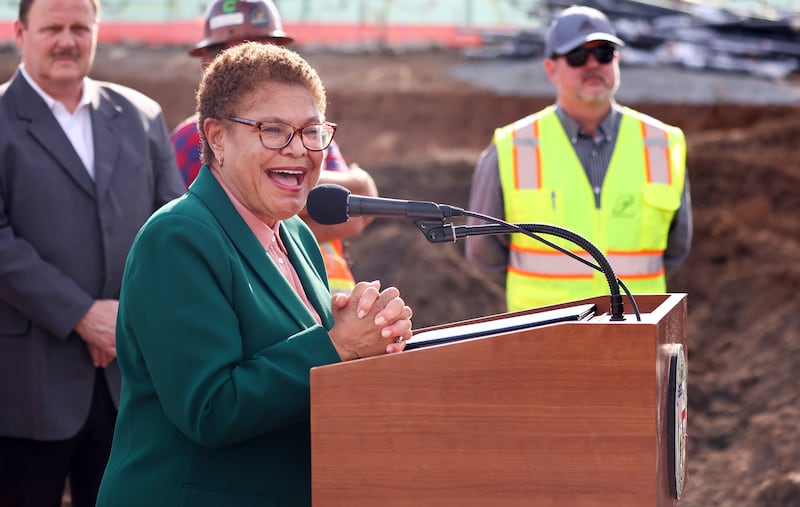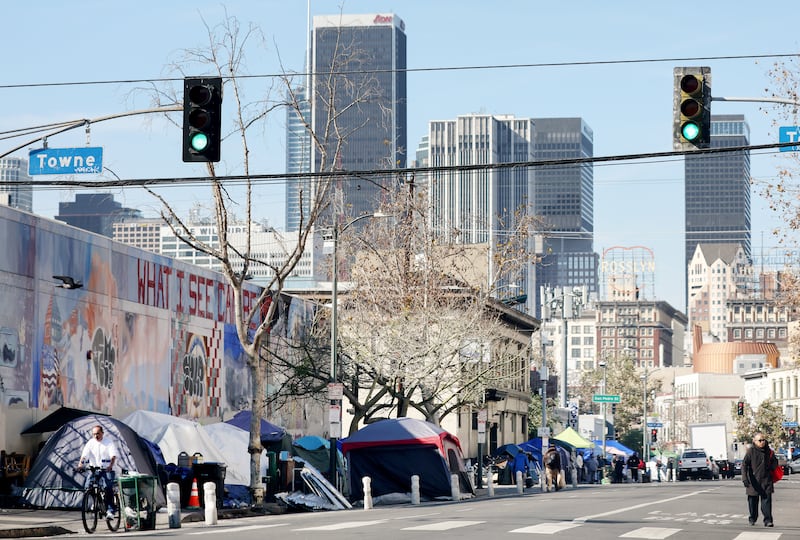Within hours of becoming mayor of Los Angeles this month, Karen Bass requested emergency powers to fight a crisis that derailed her predecessor’s grand ambitions and has left a moral cloud hanging over the city – rampant homelessness.
The emergency authority, which was unanimously granted to Bass by the city council, gives her power to bypass rules that have slowed the construction of affordable housing. It also allows the city to acquire land, hotel rooms and other property to house people.
Bass promised to bring about “a sea change in how the city tackles homelessness” as she announced the emergency resolution on December 12th. A top priority is to “decrease the size and number” of the large encampments of homeless people.
Stephanie Klasky-Gamer, president and chief executive of LA Family Housing, said she was heartened to see the mayor “acting with urgency”, which sent a hopeful message to residents.
Klasky-Gamer added that she expected “decision making to be faster” under the six-month state of emergency, which can be extended. “That’s key when you’re literally talking about people’s lives.”
Los Angeles has had a homelessness problem for decades, which was apparent to anyone who passed by the “Skid Row” area downtown. Skid Row is still there, but in recent years homeless encampments have spread out across the city: inside tunnels and atop bridges, along the banks of the Los Angeles River and in public parks, near the Venice Beach boardwalk. Crime, fires and sanitation problems have often followed.

The statistics are grim. The city’s homeless population has doubled over the past decade to about 42,000, and the number of unhoused families has risen 240 per cent in 15 years, according to city statistics. The problem is far worse than in New York and Chicago, as measured by percentage of the total population. A quarter of California’s unhoused live in Los Angeles, despite the fact that the city makes up less than 10 per cent of the state’s population.
The presence of so many unhoused people, often appearing mentally distressed and physically unwell, has shaken this liberal city’s image of itself. It is not a picture that Los Angeles will want to project to the world in 2028, when the summer Olympics come to town.
It’s not the case that we have a higher instance of substance abuse in LA than in the south or midwest
— Gary Painter, University of Southern California
Los Angeles did not arrive at this place through inaction. When Eric Garcetti became mayor in 2013, the city had about 23,000 homeless residents. Two years later, he committed $100 million to house the rapidly rising number of homeless. In 2016, Angelenos voted to approve a $1.2 billion measure to fund construction of 10,000 units of affordable housing. But more people flooded on to the streets and into shelters.
“Garcetti wasn’t absent,” said Gary Painter, director of the homelessness policy research institute at the University of Southern California. “At the end of the day, when more people are becoming unhoused than are being housed, you’re going to fall behind.”

Homelessness was the main issue in this year’s mayoral campaign, where Bass faced off against billionaire property developer Rick Caruso in the November election. Bass, a California congresswoman who had been on President Joe Biden’s shortlist for vice-president, fended off Caruso despite his $100 million campaign war chest.
Both candidates agreed that the city needed a mixture of temporary housing, whether through hotel rooms, shelters or “tiny houses”, and development of more affordable permanent housing. Garcetti’s administration oversaw the construction of thousands of units, but the costs were high: about $600,000 per unit and sometimes more.
Painter says the core of Los Angeles’s problem is “the mismatch between the rate of rent increases and income increases”.
“It’s not the case that we have a higher instance of substance abuse in LA than in the south or midwest,” he says. “But housing is more affordable in the midwest and the south – and that does explain the difference.”
Yet it is true that many of the unhoused in Los Angeles are struggling with substance abuse problems and mental illness. The city estimates that 46 per cent of the unsheltered people are suffering from addiction issues, and 34 per cent are affected by serious mental illness.
The state of California recently enacted a controversial law overhauling its procedures for dealing with people diagnosed with schizophrenia and other mental illnesses, including the ability to place them under a conservatorship if they do not agree to treatment. But homeless people in Los Angeles suffering from mental illness will still need access to care and beds until the new state policy comes into force.
Permanent housing is the end goal but not everyone is able to go from mental illness to housing, from jail to housing
— Troy Vaughn, Los Angeles Mission
In New York, mayor Eric Adams has taken a similar approach to combating homelessness since assuming office in January, including by relaxing rules that slow down construction. His administration has broken up encampments and sent police into the subway system to remove people who appear to be suffering from mental illness – even if they do not want to go.
Finding care for homeless addicts and the mentally ill in Los Angeles has often been difficult, in part because the facilities are run by the county, not the city. Klasky-Gamer of LA Family Housing noted that county officials accompanied Bass as she made her announcement this past week, which she took as a good sign. “[Bass] has worked to rebuild a good faith partnership with the county that had eroded in the last couple of years.”
In her declaration, Bass noted that Los Angeles will soon add 12,900 supportive and affordable housing units, a figure that represents some progress but lags far behind demand in a city where the average rent rose 65 per cent in the past decade.
Troy Vaughn, the president and chief executive of Los Angeles Mission, who lived on Skid Row himself in the 1990s, says a lack of affordable housing is a big factor behind the homelessness crisis. But it is only “one of the spokes in the wheel”, he added.
“Certainly the affordability of housing is a core issue that needs to be solved,” he said. “But it’s also access to healthcare and ability to get to it... Permanent housing is the end goal but not everyone is able to go from mental illness to housing, from jail to housing.” – Copyright The Financial Times Limited 2022




















